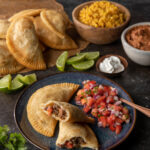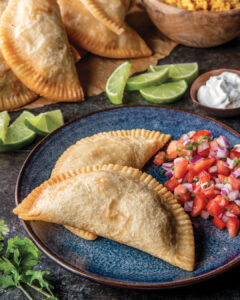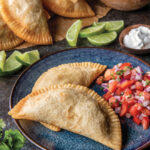

Empanadas are a delectable portable pastry made with a crisp dough and filled with endless possibilities and unique combinations. Whether you’re serving them as a main meal or a hearty snack, empanadas can satisfy any craving.
The name “empanada” comes from the Spanish verb empanar, meaning “to cover” or “to wrap or coat in bread.” Empanadas are said to have originated in Portugal and Galicia, Spain, during the medieval Moorish invasions of Iberia. Due to this, the dish most likely came from the Moors who occupied Spain during this time. Yet many areas colonized by Spain, including Mexico, Argentina, the Caribbean, and the Philippines, claim it as their own. Empanadas made with seafood are mentioned by name in a Catalan cookbook from 1520 that features Catalan, French, Italian, and Arabian dishes. Spain is where you’ll find the biggest range of empanadas, but they are a staple throughout Latin America, particularly in Argentina.
Empanadas were also once believed to be a meal of honor for the working class of Argentina. In Galicia, Spain, and Portugal, large empanadas were baked to easily feed laborers. Once the pies were cut into smaller sizes, the workers were able to easily transport them as a nutritious and lightweight meal. Depending on the filling, empanadas can be an excellent source of nutrients, as they can be high in protein and carbohydrates, giving a boost of energy.
These Spanish and Latin American pastries are stuffed with a variety of savory and sweet fillings encompassed by a dough that’s fried or baked to flaky, golden-brown goodness. In Cuba, the Dominican Republic, and Portugal, they are sometimes referred to as pastelitos. In Argentina, a flour-based dough is typically used, and a common filling is meat, hard-cooked eggs, olives, peppers, and onions. In Salta, Argentina, empanadas are typically baked, while in Tucumán, Argentina, they are often fried. Each region adds its own special touches, yet they’re all delicious.
Empanadas are most commonly made with a wheat flour or corn flour dough, but some countries call for plantains or potatoes to be used. Whether the filling is sweet or savory and whether you want to bake it or fry can determine the type of dough used. If you are baking savory empanadas, you would typically use flour, butter, salt, egg, and water for the dough; a sweet filling calls for a bit of sugar to be added. Fried empanadas traditionally use only flour, a little butter, salt, water, and possibly baking powder to give the crust a nice puff.
Once the dough is mixed, it’s thinly rolled out to a uniform thickness. Circles are cut from the dough, and the filling is added into the center of each. Empanadas need to be sufficiently filled but not overstuffed, because the filling can leak out while cooking. Make sure to leave enough space around the edges of the dough without any filling touching it to ensure the edges will stick together. To help the edges stick, lightly dip your finger or a pastry brush into cold water and brush along the entirety of the edge of the dough. The circle of dough is then folded into a semicircle with the edges aligning and then crimped to seal the filling inside. It’s said that making the perfect empanada is done entirely by hand—one hand holds the dough while the other hand spoons the filling onto the dough and then folds and crimps the edges—and in seconds.
Empanadas can be sealed and crimped in several ways. Perhaps the easiest method is to simply press the edges together with your thumb and index finger. Another way is to press the tines of a fork along the edges of the folded empanadas; this technique is often done before frying or to seal smaller empanadas. If you’re feeling fancy, repulgue the edges of the empanadas. This is done by pinching one end of the dough into a triangle and folding it onto itself and then repeating the pinching and folding all along the edge, which creates a wavy, braid-like look to the edge of the crust. You can also use an empanada press, which folds and perfectly crimps the edges for you in seconds.
There are many special celebrations during which empanadas are common, from birthdays to weddings as well as Christmastime. No matter if you’re marking a special occasion or simply enjoying a family meal, empanadas are a beloved staple.




The post Empanadas first appeared on Bake from Scratch.